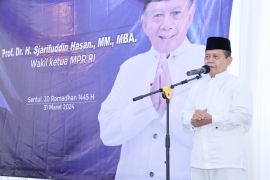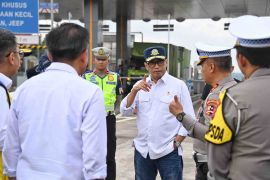The Jakarta Police had limited the operational hours of trucks and other heavy vehicles passing the downtown portion of toll roads linking cities on Java with Sumatra during the summit on May 7 and 8, 2011.
There seemed to be no other options for drastically cutting down on the perennial traffic jams in Jakarta but to keep clear the important stretch of the Inner Jakarta Ring Road from heavy vehicles except banning them from entering the city from 5 am to 10 p.m., according to the original plan.
The ban was effective from May 5 to May 9, the period of the most crucial moments for making the motorcade bringing ASEAN heads of state and government smoothly from the airport to their hotels.
The measure was found to be very effective to lessen the traffic woes so that the police and Jakarta City Administration had quickly decided to maintain the traffic arrangement for good and forgot the promise to lift the ban after May 9.
Data from the Jakarta Transportation Agency show container trucks accounted for 30 percent of vehicles on toll roads during rush hour.
Despite the success in Jakarta, the neighboring province of Banten, however, has been complaining about the onslaught of heavy vehicles flooded its roads that playing the safety valve roles as the truck could not get through to their destinations in Sumatera via Jakarta`s roads.
Mayor Airin Rahmi Diany of South Tangerang has slapped a ban on trucks traveling on the main South Tangerang in the road starting from May 26, which not allowed heavy vehicles to use the road between 5 a.m. and 10 a.m. This step was effective to stop trucks and other heavy vehicles.
The Jakarta Police`s Traffic Directorate had predicted the capital city will be packed with 12 million motor vehicles this year, , something that would only worsen Jakarta`s traffic jam.
"The number of vehicles in Jakarta tends to increase every year. We predict there will be 12,062,396 vehicles - motorcycles and cars - in Jakarta in 2011," said Indra Jafar, Jakarta`s Traffic Management Center coordinator, adding the figure would not include 859,692 public transportation vehicles operating in the capital.
Indra expressed concern that the increasing number of vehicles would worsen the traffic jam in Jakarta since the growing number of vehicles was not followed by the building of new roads.
Jakarta loses an average of US$1.43 billion per year as the result of traffic congestion, according to a recent report by the Presidential Work Unit for Development Monitoring and Control.
In fact, road traffic congestion in other five major cities in the country, Bandung, Surabaya, Makassar, Medan and Denpasar, whose rate of severity have reached an extremely worrying level, said Coordinating Minister for the Economy Hatta Radjasa last Thursday.
The minister made the statement after attending a meeting with governors and senior officials of all provinces in the country to discuss the problem of traffic jams and the implementation of infrastructure projects such as airports, railway roads and sea ports in some parts of the country.
Asked about the budget that the government will spend to build the infrastructure projects to tackle traffic jams in the six cities, yet Hatta could not give a figure.
Dismaying Infrastructure
The dismaying infrastructure has caused disadvantages to the business sector, especially the roads in many cities as deliveries have suffered a lot, said Sofyan Wanandi, chairperson of Indonesian Businessmen Association (APINDO) said on Friday (May 27).
"There has been almost no new infrastructure building in the last 15 years but only patchwork here and there. We`ve often complained of the bad infrastructure and we got nothing except promises," said Wanandi, adding the business sector wants the promises realized.
On the re-routing of heavy vehicles and trucks away from Jakarta streets and roads, Wanandi said has caused a great loss to the business and industrial sectors because the longer itineraries meant a longer delivery time and increased fuel consumption. The situation has reduced competitiveness of products on their way to export destinations.
Anoop Singh is director of the IMF`s Asia & Pacific Department has lavished Indonesia with all the economic figures in his article carried by Alpha South East Asia magazine, written in January 2011. The only factor he has highlighted negatively is the infrastructure condition.
Economic growth is targeted by the government to accelerate from 6 percent this year to 7-8 percent over the medium term. For Indonesia to achieve these levels, it will need to address long-standing constraints of growth.
"Public investment has been low by international standards. Roads and ports in particular need improvement," Singh points out.
President Susilo Bambang Yudhoyono recently made infrastructure projects a key priority in his Independence Day speech and recent developments show policies are moving in the right direction.
Edward H. Carpenter is a US Marine Corps Foreign Area Officer, based in Jakarta, writes in a recent article, not related to his official designation, that "Indonesia`s economy is demonstrating an overall growth, and this trend will likely continue, but it is very much in danger of becoming a victim of its own success."
This is due largely by the lack of workable infrastructure, which does not satisfactorily address the current economy and will slow down future economic growth.
The trans-Sumatra highway which links the port at Bakauheni with the factories and plantations in the mountainous island is reduced to two lanes, pitted and cratered in many places like a bombed runway.
"A continuous stream of giant, heavily laden trucks, passenger buses and swarms of over-laden scooters labor to navigate the tortuous roads," he observes.
Within the confines of large cities like Jakarta, it`s even worse. The roads, while better maintained, can`t handle the volume of cars, minibuses, and the ubiquitous scooters (over five million of them) that carry workers in the countryside.
A lack of workable public transportation and often inefficient routing methods can transform a straight five km drive along a major road, into a twisting 30 minute route on a good day 90 minutes if it`s raining (nearly every afternoon from October through May). (*)
Reporter: By Vicki Febrianto
Editor: Kunto Wibisono
Copyright © ANTARA 2011











